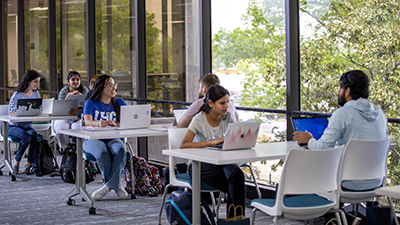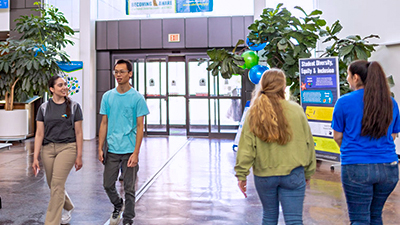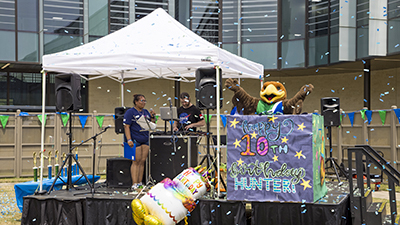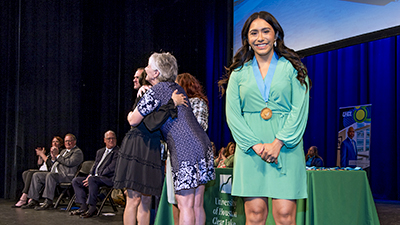Professors win award for speed dating-inspired classroom activity

Speed dating has been helping singles meet since the late ‘90s, but for a University of Houston-Clear Lake (UHCL) research team, it inspired an award-winning research project that ultimately enhanced student connections in the classroom. Five faculty members from the College of Human Sciences and Humanities (HSH) worked on the research project: Drs. Christal Seahorn, Lisa Sublett, Amanda Johnston, Christine Walther, and Georgina Moreno.
Also part of the research team was Latoya Brownlee, a UH-Clear Lake alumna, who contributed to the research by collecting data and identifying key themes from the data. They named the project “Speed-Interviewing for Classroom Group Formation: How a Clever Twist on the Classic ‘Speed-Dating’ Tradition Enhances Small Group Coursework.”
The project’s inception dates back to 2013 when Seahorn presented on the topic of "Collaboration in the 21st Century” after winning the Teaching Innovation Award. After repeatedly allowing her students to choose their groups in her writing classes, she noticed that many chose based on friendships or proximity. This led her to develop the speed-dating activity to encourage students to “prioritize topic investment and work styles when selecting group partners.”
Realizing the approach’s benefits, Johnston began implementing the activity in one of her psychology classes. After seeing the benefits in her classroom over the years, she later suggested developing a research project to track student feedback and test the activity’s effectiveness. She and Seahorn then recruited the rest of the research team to develop the study.
“Our research examined the effectiveness of an innovative group formation activity in higher education classrooms, inspired by the speed-dating exercises commonly featured in popular culture,” said Johnston. “HSH’s courses in writing, psychology, and industrial/organizational psychology served as a platform to explore our innovative ‘speed-dating’ activity in forming groups in classroom settings.”
Johnston and her colleagues implemented the “speed-dating” activity during their individual classes — 15-40 students per class — by first breaking their students up in small groups of three to five. Each student selected a topic of interest and spent 60 seconds with each classmate in their group to discuss the topic. The immediate goal of the activity was to find the most effective student combinations for future group assignments. After the discussions, students completed a structured rating sheet to list their preferred partners for these assignments.
“This creative approach to team formation allowed students to select their preferred teammates, instilling a sense of ownership and commitment to the team's success,” explained Seahorn. “Nevertheless, the final groupings were determined by the professors, simulating real-world scenarios where team assignments are often made by supervisors or managers.”
“This unique activity … enhanced student connections and fostered greater interaction, proving especially effective in facilitating team formation based on shared interests.”
At the end of the semester, students had the option to share their thoughts anonymously on the activity. The research team then analyzed the qualitative and quantitative responses, many of which were positive.
“We determined several benefits, including its time efficiency and strategic group formation based on topic interest alignment,” Sublett said. “It enabled active student engagement through feedback and effectively reduced common biases.”
Walther added that many students enjoyed the experience and are looking forward to participating in the activity again in other classes, with other professors.
“This unique activity was well-received by students, many of whom expressed enthusiasm for future participation and recommended its adoption by other professors,” she said. “Our findings indicate that the activity enhanced student connections and fostered greater interaction, proving especially effective in facilitating team formation based on shared interests.”
Although other faculty members can use the activity, the research team suggests it be limited to classes with no more than 40 students. The team also mentioned the required time dedication, for which classroom projects it would be ideal, and when the best time is to execute it.
“The ‘speed-dating’ activity does require a significant amount of time, ranging from 45 minutes to 2 hours, depending on the class size,” Sublett said. “We suggest this activity be used for projects where topic congruence is a priority. Implementing this activity at the beginning of the semester, when students are not yet acquainted, maximizes its benefits.”
According to Moreno, one of these benefits involved the students’ overall vibe about the class after completing the activity. She said it positively impacted the overall classroom atmosphere, especially during the first couple weeks of the semester.
“It motivated students to interact with peers they might not normally engage with, promoting a more inclusive and welcoming environment from the outset,” she said. “Students valued the opportunity for groups to form based on meaningful attributes, such as shared topic interests.”
The research team members published their speed-dating activity and findings in Teaching of Psychology. They were also acknowledged by UHCL’s Center for Faculty Development, which annually honors faculty members who demonstrate intellectual inquiry, scholarship, and creative engagement. The Center awarded Sublett, Johnston, Walther, Seahorn, Moreno, and Brownlee with the Scholarship to Improve Higher Education for publishing their data to improve academia.
If you’re a professor interested in using the speed-dating activity in your classroom, you can find detailed instructions on Figshare.








